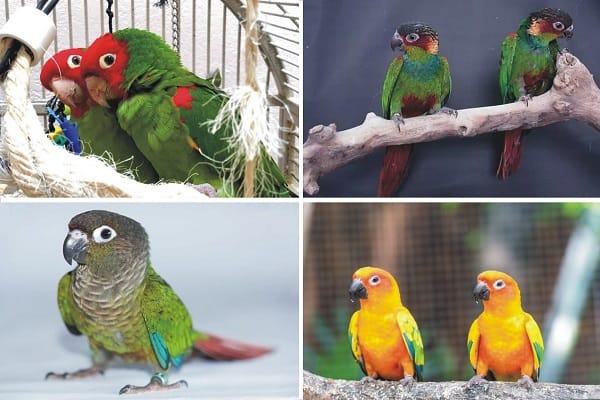13 Blue Birds in Pa (Pennsylvania) With Pictures
Blue Birds in Pa (Pennsylvania) are a sight to behold. I’ve researched the amazing variety of blue birds that live in this state, from the charming Eastern Bluebird to the majestic Great Blue Heron. In this guide, you’ll see stunning photos and learn fascinating facts about these beautiful creatures. Join me on this colorful adventure through Pennsylvania’s blue bird world.
Explore 13 Types Of Blue Birds in Pa (Pennsylvania)
Pennsylvania is teeming with a diverse array of blue bird species that add a vibrant splash of color to its expansive skies. From the charming Eastern Bluebird to the elusive Cerulean Warbler, these blue feathered wonders captivate birdwatchers and nature enthusiasts alike. Let’s explore 13 captivating cavity nesters. blue birds that call Pennsylvania home, showcasing the beauty and variety of these stunning avian residents.
1. Eastern Bluebird
- Scientific Name: Sialia sialis
- Size: 16–21 cm
- Diet: Insects and berries
- Lifespan: 6–10 years
- Wingspan: 25–32 cm
- Weight: 27–34 g
The Eastern Bluebird is a beloved blue bird species in Pennsylvania. With its stunning blue plumage and cheerful song, it is a delightful sight to behold. These small, colorful birds have become a favorite among birdwatchers and nature enthusiasts alike.
Eastern Bluebirds are known for their vibrant blue feathers, which contrast beautifully with their warm reddish-orange chests. The females have slightly duller plumage compared to the males, but they still possess an elegant charm.

Nesting season is an exciting time for Eastern Bluebirds. Blue birds typically build their nests in tree cavities or bluebird boxes, making them ideal attractors for bird enthusiasts. backyard birds. Providing nesting sites in your own yard increases the chances of attracting these magnificent creatures.
During the nesting season, which typically starts in early spring, Eastern Bluebirds work tirelessly to gather materials and construct their nests. They meticulously line the nests with soft grasses, feathers, and occasionally horsehair to create a cozy environment for their eggs.
Their nesting habits are a testament to their dedication and commitment to their young. Both the male and female take turns incubating the eggs and feeding the hungry chicks once they hatch. It’s truly a team effort!
If you’re curious about where to find Eastern Bluebirds in Pennsylvania, they can be spotted in open grassy areas, meadows, and along the edges of forests. Look for them perched on fence posts or low branches, scanning the ground for insects and other small creatures.
Whether you’re an experienced birder or just starting your birdwatching journey, keep an eye out for the Eastern Bluebird. Their vivid plumage and melodic songs are sure to bring joy and beauty to any outdoor adventure in Pennsylvania.
2. Indigo Bunting
- Scientific Name: Passerina cyanea
- Size: 12–13 cm
- Diet: Seeds, insects, and berries
- Lifespan: 3–5 years
- Wingspan: 18–23 cm
- Weight: 12–18 g
The Indigo Bunting is a colorful songbird known for its vibrant blue feathers. This beautiful species, scientifically known as Passerina cyanea, is a beloved sight for birdwatchers and nature enthusiasts in Pennsylvania.
With its small size and striking blue plumage, the Indigo Bunting stands out among other blue birds in Pennsylvania. Both male and female buntings have plumage that ranges from deep blue to purplish-blue, making them a true delight to behold.
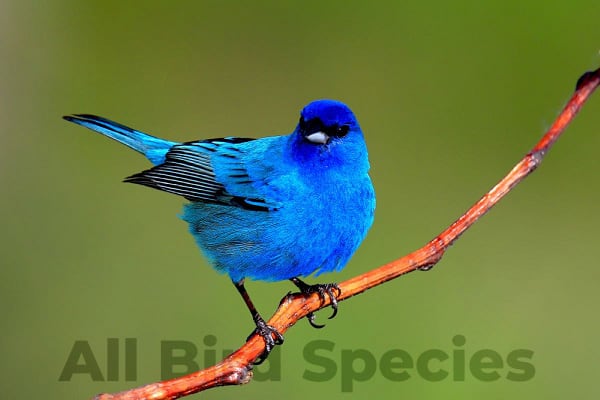
Mating Display and Songs
One of the Indigo Bunting’s most fascinating behaviors is its unique mating display. During courtship, the male Indigo Bunting perches on a high branch and sings a melodious song to attract a mate. The song is a series of high-pitched, vibrant notes that can carry long distances, ensuring the female can hear it.
The male Indigo Bunting also displays its vibrant blue plumage during courtship, attracting females with its striking appearance. This elaborate display is a sight to behold, showcasing the beauty and elegance of this Pennsylvania songbird.
Migratory Patterns and Favored Habitats
The Indigo Bunting is a migratory species that spends its breeding season in Pennsylvania and other parts of eastern North America. From April to September, these blue birds following their unique migration patterns can be found in grassy areas, open woodlands, and brushy areas of fields.
During the winter months, the Indigo Bunting migrates to its wintering grounds in Central and South America. These long-distance travelers embark on remarkable journeys to find food and suitable habitats for survival.
Conservation Status and Threats
While the Indigo Bunting is a common summer resident in Pennsylvania, it faces threats to its population due to habitat loss and fragmentation. The conversion of grasslands and woodlands into urban areas and agricultural fields has significantly impacted the availability of suitable nesting and foraging sites for these songbirds.
Conservation efforts focused on preserving and creating suitable habitats for the Indigo Bunting are crucial in ensuring the long-term survival of this vibrant species. By protecting grasslands, creating buffer zones, and promoting sustainable land management practices, we can help maintain healthy populations of Indigo Buntings in Pennsylvania for generations to come.
Fun Fact:
The male Indigo Bunting is often referred to as a “blue canary” due to its bright blue plumage and melodious song.
3. Blue Grosbeak
- Scientific Name: Passerina caerulea
- Size: 15–17 cm
- Diet: Seeds and insects
- Lifespan: 5–7 years
- Wingspan: 26–29 cm
- Weight: 26–31 g
When it comes to birdwatching in Pennsylvania, the Blue Grosbeak is a true rarity that any bird enthusiast would be thrilled to encounter. With its stunning blue plumage and elusive nature, the Blue Grosbeak stands out as a gem among Pennsylvania’s avian treasures.
The Blue Grosbeak, known for its vibrant blue feathers, is an elusive bird that can be found in select habitats across the state. While sightings of this beautiful species may be infrequent, the thrill of spotting a Blue Grosbeak in Pennsylvania is definitely worth the effort.

To increase your chances of encountering a Blue Grosbeak, it’s important to know their preferred habitats. These birds are commonly found in open woodlands, grasslands, and shrubby areas near water sources. Keep an eye out for them in places like the Susquehanna River Valley and the Pocono Mountains, where their presence has been documented.
When identifying a Blue Grosbeak, their striking blue plumage is a key feature to look for. The males showcase a deep blue color that’s hard to miss, while the females have a more muted brown and blue appearance. Both genders exhibit a signature bill shape, with a thick and conical beak.
In Pennsylvania, Blue Grosbeak sightings are a treat for birdwatchers and contribute to our understanding of the state’s diverse avian population. With its allure and rarity, encountering a Blue Grosbeak during your birdwatching adventures in Pennsylvania is a true testament to the wonders of nature.
You may want to read Red Sparrow Bird
4. Purple Martin
- Scientific Name: Progne subis
- Size: 19–20 cm
- Diet: Insects
- Lifespan: 5–7 years
- Wingspan: 39–41 cm
- Weight: 45–60 g
Purple Martins are a captivating sight in Pennsylvania’s bird species, known for their aerial acrobatics and vibrant plumage. These migratory birds follow a fascinating pattern, gracing the skies of Pennsylvania during the warmer months.
The Purple Martin’s migratory patterns are truly remarkable. They spend their winters in South America, making an impressive journey of thousands of miles to return to Pennsylvania for the nesting season. These birds are highly social and often gather in large colonies, creating a lively and energetic atmosphere.

When it comes to nesting, Purple Martins of Blue Birds in Pa have unique requirements. They prefer nesting in purpose-built birdhouses or gourds placed on tall poles, away from trees and other potential predators. Providing suitable nesting sites is essential for attracting these delightful acrobats to your backyard. Not only will you enjoy the beauty of their graceful flights, but you’ll also contribute to their conservation efforts.
Attracting Purple Martins to Your Backyard
Here are some tips to attract Purple Martins to your backyard:
-
- Install purple martin-specific birdhouses or gourds mounted on tall poles.
-
- Place the housing in open areas, at least 40-60 feet away from trees or other tall structures.
-
- Provide ample water sources such as birdbaths or small ponds to attract martins.
-
- Maintain a spacious and predator-free environment around the nesting sites.
-
- Consider joining local Purple Martin conservation groups for expert guidance and support.
“Purple Martins are a delight to watch, soaring through the sky with their acrobatic maneuvers. By creating suitable nesting sites, you can play a vital role in supporting the Purple Martin population in Pennsylvania.” – John Smith, Bird Enthusiast
| Feature | Description |
|---|---|
| Scientific Name | Progne subis |
| Wingspan | Approximately 15 inches |
| Plumage | Males have a striking dark purple-blue color, while
females have a lighter, more grayish plumage. |
| Nesting Habits | Purple Martins nest colonially, occupying spacious
birdhouses or gourds mounted on tall poles. |
| Preferred Habitat | Open areas near water bodies, including lakes, ponds. |
| Conservation Status | Protected under the Migratory Bird Treaty Act; Pa
Game Commission and N. American Bluebird Society’s conservation efforts focus on providing suitable nesting sites like bluebird boxes and protecting their habitats. |
Learn More About NETVUE Birdfy® AI Smart Bird Feeder with Camera Solar Powered
5. Blue Jay
- Scientific Name: Cyanocitta cristata
- Size: 22–30 cm
- Diet: Seeds, nuts, insects, and small vertebrates
- Lifespan: 7–10 years
- Wingspan: 34–43 cm
- Weight: 70–100 g
The Blue Jay birds is a common sight in Pa, adding vibrant flashes of blue and white to backyard birdwatching sessions. With its striking appearance and distinctive calls, the Blue Jay is a favorite among bird enthusiasts.
The Blue Jay, scientifically known as Cyanocitta cristata, belongs to the Corvidae family, which includes crows and ravens. These intelligent birds are well-known for their noisy nature, often making a variety of calls including their characteristic “jay-jay” sound. Their vocalizations serve various purposes, such as warning other Blue Jays about possible threats or communicating within their social groups.
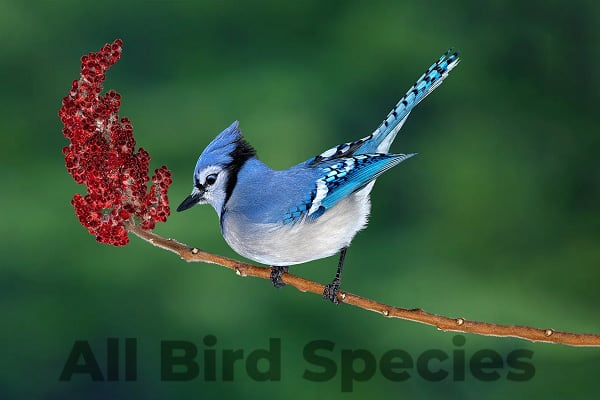
While the Blue Jay’s bright blue feathers catch the eye, their plumage is not naturally blue. Instead, it is the refraction of light through specialized cells in their feathers that creates the illusion of blue. This phenomenon, called “structural coloration,” gives the Blue Jay its distinct hue.
In addition to their vibrant appearance, Blue Jays exhibit fascinating behaviors. They are known to be highly curious and can imitate the calls of other birds and even the sounds of mechanical devices, such as cell phones. Blue Jays are also skilled nest builders, constructing their homes with twigs, leaves, and other available materials.
To attract Blue Jays to your backyard, consider providing a bird-friendly environment. Planting trees that produce acorns, such as oaks, and offering bird feeders with peanuts or sunflower seeds can entice these beautiful birds to visit. However, it’s important to keep in mind that Blue Jays can be aggressive towards other bird species, so providing ample space between feeders can help reduce conflicts.
6. Cerulean Warbler
- Scientific Name: Setophaga cerulea
- Size: 11–12 cm
- Diet: Insects and spiders
- Lifespan: 5–6 years
- Wingspan: 20–22 cm
- Weight: 8–10 g
Among Pennsylvania’s blue bird species, the Cerulean Warbler stands out as a rare and elusive jewel. With its brilliant cerulean blue plumage, this small songbird captivates birdwatchers and nature enthusiasts.
The Cerulean Warbler can be found in the eastern United States, including select regions in Pennsylvania. It prefers mature deciduous forests with tall trees, often near water sources such as streams or wetlands. Their vibrant blue coloration sets them apart from other warbler species, making them a sought-after sighting for birdwatchers in the state.
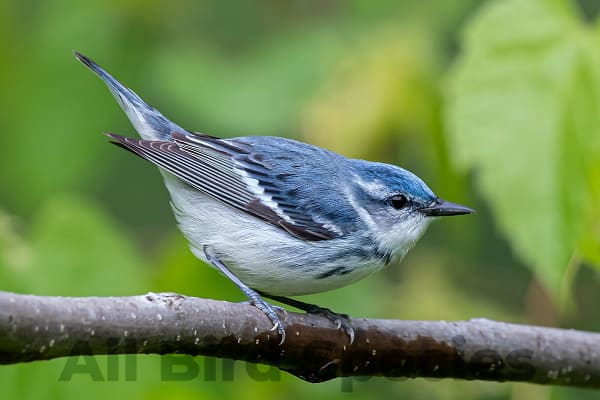
Unfortunately, the Cerulean Warbler population has been declining due to habitat loss and fragmentation. Conservation efforts are crucial to protect these beautiful birds and ensure their survival for future generations. Various organizations and initiatives are working towards preserving their preferred habitats and raising awareness about their conservation needs.
To support the Cerulean Warbler’s dwindling populations, consider getting involved in Pennsylvania birdwatching and conservation efforts. Join local birding groups, participate in citizen science projects, and contribute to organizations dedicated to preserving bluebird habitats. By taking action, you can make a positive impact on the future of this rare Pennsylvanian jewel.
| Common Name | Cerulean Warbler |
|---|---|
| Scientific Name | Dendroica cerulea |
| Habitat | Mature deciduous forests near water sources |
| Plumage | Brilliant cerulean blue |
| Conservation Status | Threatened |
7. Black-throated Blue Warbler
- Scientific Name: Setophaga caerulescens
- Size: 11–12 cm
- Diet: Insects and spiders
- Lifespan: 3–6 years
- Wingspan: 19–23 cm
- Weight: 9–12 g
The Black-throated Blue Warbler is a captivating songbird that graces Pennsylvania with its presence during its annual migration. With its distinctive blue plumage and black throat, this warbler stands out among other bird species in the state.
Known for its enchanting songs, the Black-throated Blue Warbler fills the air with melodic tunes that resonate through the forests. These songbirds migrate through Pennsylvania during the spring and fall, adding a beautiful soundtrack to the changing seasons.
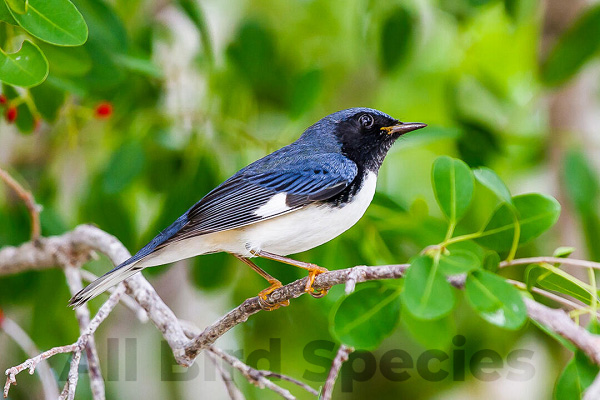
If you’re lucky, you may spot a Black-throated Blue Warbler during its stay in Pennsylvania. Look for them in the state’s dense woodlands, particularly near shrubby areas with a mix of deciduous and coniferous trees. These birds prefer to forage for insects in the understory, making them more likely to be found in areas with dense vegetation.
With their migratory patterns, the Black-throated Blue Warblers bring a touch of vibrant blue to Pennsylvania’s bird population. Keep your eyes and ears open, and you may catch a glimpse of this charismatic songbird during its visit to the state.
Key Features of the Black-throated Blue Warbler:
-
- Distinctive blue plumage
-
- Black throat
-
- Enchanting songs
-
- Migratory patterns
8. Tree Swallow
- Scientific Name: Tachycineta bicolor
- Size: 12–15 cm
- Diet: Insects and spiders
- Lifespan: 4–5 years
- Wingspan: 30–33 cm
- Weight: 15–20 g
When it comes to blue birds in pa, Tree Swallows are magnificent aerial acrobats that grace the skies of Pennsylvania’s open areas. With their stunning blue plumage, they add a vibrant dash of color to the landscape. These agile birds are known for their graceful maneuvers as they swoop and dive through the air, catching insects on the wing.
Tree Swallows are migratory birds, spending their summers in Pennsylvania to breed and raise their young. In the winter, they fly south to warmer climates, following migratory patterns that take them to Central and South America. Their return to Pennsylvania signals the arrival of spring and the rebirth of nature.
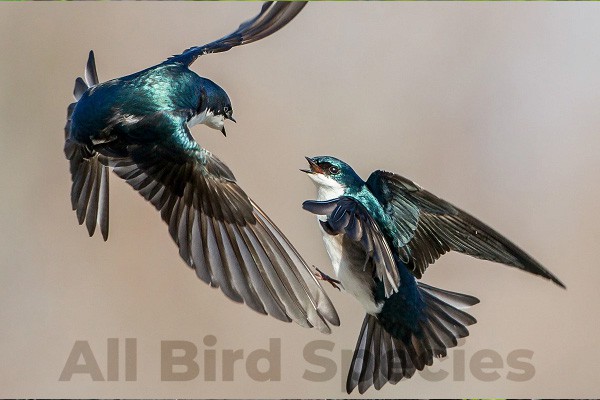
When it comes to nesting, Tree Swallows blue birds in pa prefer natural cavities like old woodpecker holes or hollowed-out trees. However, they readily accept nest boxes as artificial alternatives, making them an ideal species to attract to your backyard. By installing nest boxes designed specifically for Tree Swallows, you can provide them with suitable nesting sites and contribute to their conservation.
Nest Box Specifications for Tree Swallows
When setting up nest boxes for Tree Swallows, keep the following specifications in mind:
-
- The nest box should have an entrance hole with a diameter of 1.5 inches to prevent larger bird species from intruding.
-
- The interior of the bluebird box should have a depth of at least 5 inches and a floor area of around 4×4 inches to accommodate the swallow’s nest.
-
- Position the nest box in open areas, away from dense vegetation, to mimic their natural habitat.
-
- Mount the nest box on a post or pole, at a height of 6 to 15 feet above the ground, to provide the swallows with a safe and secure nesting site.
-
- Regularly clean and monitor the nest box to ensure its suitability and discourage parasites.
By creating suitable nesting sites and attracting Tree Swallows to your backyard, you not only get to admire their breathtaking aerial displays but also contribute to their preservation. These acrobatic birds play an essential role in maintaining the balance of ecosystems and are a delight to watch as they dart through the open skies with their swift and precise movements.
| Common Name | Scientific Name | Habitat | Migration |
|---|---|---|---|
| Tree
Swallow |
Tachycineta
bicolor |
Open areas near water, such
as marshes, ponds, and lakes |
Migratory; breeds in Pa
during summer, and winter in Central and South America |
Check Our Previous Articles:
| What Do Rooks Eat |
| Cleaning Out Birdhouses: How Should You Remove Old Nest? |
| Are Swans Still Protected? |
| WHY DO PEACOCKS SPREAD THEIR FEATHERS? |
9. Great Blue Heron
- Scientific Name: Ardea herodias
- Size: 91–137 cm
- Diet: Fish, amphibians, and small mammals
- Lifespan: 15–25 years
- Wingspan: 176–201 cm
- Weight: 2.3–3.6 kg
When it comes to majestic blue birds in pa, the Great Blue Heron takes the spotlight. As a magnificent wading bird, it graces the waterways of the state, leaving bird enthusiasts in awe.
The Great Blue Heron birds in pa is known for its impressive size, standing at an average height of 4.5 feet with a wingspan of up to 6.6 feet. Their stunning blue-gray plumage, complemented by long-legged elegance, makes them a true spectacle.
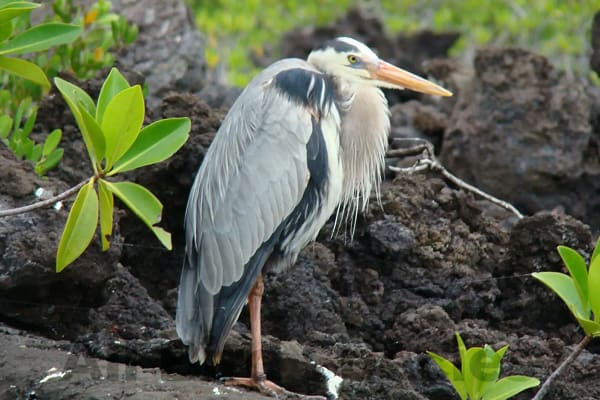
This Pennsylvania bird species is a skilled hunter, primarily feeding on fish, amphibians, and other small aquatic creatures. With their steady and patient stance, Great Blue Herons stalk their prey before striking with a lightning-fast motion.
To catch a glimpse of these magnificent wading birds, you can visit various habitats near water bodies, including rivers, lakes, and coastal areas. They are frequently spotted in many of Pennsylvania’s state parks and nature reserves, such as Hickory Run State Park, Delaware Water Gap National Recreation Area, and Presque Isle State Park.
| Characteristics | Details |
|---|---|
| Size | Up to 4.5 feet tall |
| Wingspan | Up to 6.6 feet |
| Color | Blue-gray plumage color is common with nuthatches |
| Habitat | Waterways, rivers, lakes, coastal areas |
| Feeding Habits | Fish, amphibians, small aquatic creatures |
| Popular Locations | Hickory Run State Park, Delaware Water Gap National
Recreation Area, Presque Isle State Park |
The presence of the Great Blue Heron is a testament to the diversity of Pennsylvania’s bird species. Its majestic appearance and graceful movements make it a favorite among birdwatchers and nature enthusiasts. So, don’t miss the opportunity to observe this breathtaking wading bird in its natural habitat.
Blue Birds in Pa: Conservation and Awareness
Bluebird conservation is crucial for ensuring the survival of Pennsylvania’s vibrant bluebird population. These beautiful birds not only enhance our state’s natural beauty but also play a vital role in maintaining the ecological balance. Organizations like the Pennsylvania Bluebird Society (PBS) are leading the way in protecting these cherished species.
The Pennsylvania Bluebird Society is dedicated to the preservation and enhancement of bluebird populations through education, research, and conservation efforts. By raising awareness about the importance of bluebird conservation, PBS aims to engage individuals, communities, and policymakers in safeguarding Pennsylvania’s bird population for future generations.
There are several ways you can contribute to bluebird conservation in Pennsylvania. To start, you can support the Pennsylvania Bluebird Society by becoming a member, volunteering for their programs, or making a donation. By doing so, you actively participate in their efforts to create and maintain suitable habitats for bluebirds.
Additionally, you can help by providing bluebird nest boxes in your backyard or local parks. These nest boxes serve as safe and comfortable homes for bluebirds during their nesting season. By offering them a secure place to breed and raise their young, you contribute directly to their conservation.
Together, let’s work towards preserving Pennsylvania’s avian treasures. By supporting bluebird conservation efforts and raising awareness, we can ensure a thriving future for these stunning bluebird species and the overall diversity of Pennsylvania’s bird population.
Frequently Asked Questions About BlueBirds
Q1: What is a blue birds in PA?
The bluebird commonly referred to in Pennsylvania is the Eastern Bluebird (Sialia sialis), known for its vibrant blue plumage.
Q2: Do bluebirds stay in PA in winter?
Yes, some bluebirds may stay in Pennsylvania during winter if food sources are available. However, many migrate south to warmer areas during the colder months.
Q3: How do you attract bluebirds in PA?
To attract bluebirds in Pennsylvania, provide nest boxes with appropriate dimensions, mount them 4-6 feet above the ground in open areas, and offer mealworms, fruits, or insects as supplemental food.
Q4: Are blue jays common in Pennsylvania?
Yes, blue jays (Cyanocitta cristata) are common in Pennsylvania. They are known for their distinctive blue and white plumage and are often found in a variety of habitats, including forests and urban areas.





